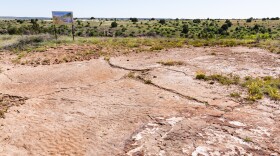In a letter sent to OMC Chairman Myron Red Eagle on Wednesday, Osage Principal Chief Geoffrey Standing Bear wrote the tribe was working with the Department of the Interior to redirect production, permitting and leasing responsibilities currently held by the BIA to the Osage Minerals Council in fiscal year 2026.
The Osage Minerals Council is an elected, eight-member body responsible for governing all mineral rights in Osage County. The tribe receives income from all oil and gas within the county.
"With this assumption, you would maintain hiring and firing authority of OMC employees while following Osage Nation personnel policies and laws," Standing Bear told Red Eagle.
The letter also includes a potential organizational chart for the estate under the OMC. It lists around $1 million in DOI funding.
In a statement released the same day, Standing Bear wrote Osage Nation could not rely on the BIA to stay open.
"The Department of the Interior made its intentions clear during the first Trump administration that it was looking for an 'exit ramp' on Indian Affairs. Now, the Department of Government Efficiency has put this into action by making significant cuts to the BIA," Standing Bear wrote. "It is clear that the BIA will not be around forever, and we must intervene to save the staffing infrastructure; otherwise, the Osage Minerals Estate will lose critical administrative positions."
Standing Bear also said the tribe is capable of taking over the estate.
"Osage Nation is committed to full self-governance, and all our governmental bodies must be prepared to rise to the call for sovereignty," Standing Bear wrote. "We are ready to take on the responsibilities and challenges that come with this transition, and we are confident in our ability to succeed."
Trump's proposed fiscal-year-ending 2026 budget includes cutting nearly $1 billion from tribal programs. It would cut more than $700 million from the Bureau of Indian Affairs and more than $230 million from tribal housing programs.
Earlier this year, the Department of Government Efficiency attempted to close 25 BIA offices across the country, including one in Osage Nation. But the tribe kept it open after negotiating with the federal government.
On Tuesday, Standing Bear and Paul Revard, a Minerals Council board member, attended a consultation session in Oklahoma City with representatives from the Department of the Interior, alongside multiple other tribes. The meeting was one of six held in person across the country.
According to a letter from the Department of the Interior, the federal government desired input from tribes regarding the restructuring of the BIA and current funding mechanisms.
Standing Bear and Revard did not think this was the case.
"The overall thought is that these plans that they're proposing, the reorganization have already been established. And now they're doing the consultation to just check a box," Revard said. "That's been kind of a common theme throughout this morning."
This echoed similar statements made by other tribal leaders, who were concerned the federal government's direction with the BIA was unclear.
This report was produced by the Oklahoma Public Media Exchange, a collaboration of public media organizations. Help support collaborative journalism by donating at the link at the top of this webpage.









